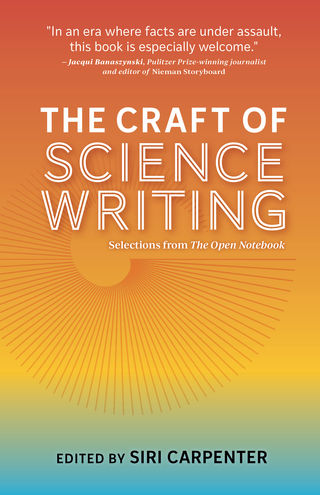Media
What Scientists Can Learn From Science Writers
If it isn’t communicated, there’s no point to any of it.
Posted April 23, 2020
There’s a lot of discussion among scientists about ways to improve academic writing and about engaging with the public. Some of these solutions are to use social media like Twitter, to get media-trained by the communications department at the university, or even to start writing for the public to improve one’s academic thinking and writing.
However, a new book edited by distinguished science writer Siri Carpenter seeks to illuminate The Craft of Science Writing by collecting numerous perspectives from science writers themselves about how to improve their own craft of science writing. This book is an edited version of entries from a long-running project known as The Open Notebook: The Story Behind the Best Science Stories, where science writers have generously provided examples of how they pitch editors and how their stories have been shaped.
The conversation among scientists themselves has not yet included learning from science writers and editors themselves, and thus this new volume, in my view, is important to read for scientists to understand what it is that science writers do, what it means to tell a great story about science, and the incentive structure that science writers are under especially as journalism is rapidly shifting.
As the Pulitzer Prize-winning journalist Jacqui Banaszynski writes on the cover, “In an era where facts are under assault, this book is especially welcome.” Siri kindly took her time to answer some of my questions about her new book, and I hope that more scientists will consider what they can learn from science writers themselves.
What can scientists learn from science writers about storytelling and writing?
Science writers and scientists share some core goals in common. The aim of any storytelling or writing, no matter who you are, is to draw people into your story, to provide them with clear and accurate information, to present it in a way that engages people to keep reading, and to leave them with some kind of trace of the whole experience.
That’s true whether your purpose is to spark some kind of action, or whether it’s simply to inform or entertain. There’s no point to any of it if no one is going to read it or understand it or remember it. And that’s true whether you are a professional science writer or a scientist who wants to communicate with your peers and students, or with those who review your grant proposals, or with the general public.
One thing that science writers tend to learn early is that the stories that have the most impact are most often those that balance data with stories. Humans are natural storytellers, and while facts and hard data matter, and are needed, what people are touched by and remember are the stories.
As an example, think about the way that we respond to the unfolding, horrific news about the COVID-19 pandemic. We are absolutely inundated with numbers—how many people have been infected, how many hospitalized, how many dead, how many people have been tested, how many masks or ventilators are left, how many have applied for unemployment benefits, how many refrigerated trucks are sitting on New York streets, how many people stood in line to vote during Wisconsin’s spring elections, how many millions of dollars have been disseminated in small-business loans, and so on.
We need to know those numbers. But alone, they are just numbers. They don’t speak to us in the way that stories of individual human lives do. Any individual story does not in itself provide the full picture, so we need the numbers—but it’s the stories that stay with us.

How might scientists or academics benefit from reading The Craft of Science Writing and how science writers talk about their own craft? Could this be incorporated in some way into media training of academics?
Crafting science stories requires a number of different skills. For example, it requires that a person is able to recognize what makes a scientific development newsworthy or noteworthy to a specific audience, and putting that idea in context. It requires being able to dig up information that’s hard to find, or that doesn’t “want” to be found. It requires structuring stories to hook readers from the start and keep them reading to the end. It requires expressing ideas clearly, without falling into jargon or clichés. It requires being able to write about controversial topics without falling for misinformation or becoming prey to the tendency toward "false balance.” And it requires fact-checking your own work properly.
These are all important parts of being a science writer, whether you’re a journalist or an institutional science writer or a scientist who is interested in communicating more effectively. No one is good at all these things immediately—they take practice and feedback and a willingness to learn from mistakes.
The Craft of Science Writing uncovers some of the methods that science writers find to work best, and it also shows the human side of science writing, which is all too often misunderstood. Scientists can read it to understand the roles science writers play, and to improve their understanding of the craft so they can better incorporate some of the lessons into their own work.
What are the things science journalists most want scientists to know about what goes into the craft of a science story?
At root, science and science journalism share many similar goals. Science and journalism are both driven by curiosity, and sometimes by the desire to right some wrong. And they both depend on rigorous information-gathering and an awareness of the potential for bias or hype to tarnish their work. That’s why scientists regard peer review as so vital to a study’s credibility.
Likewise, science journalism’s potential to illuminate truths depends on journalists bringing independence and skepticism to their role, too. Science journalism is more than cheerleading, or “promotion” of science.
That’s why science writers seek out experts who weren’t involved in a study to provide “outside comment” on the research. And it’s why science journalists can’t let scientists read their stories before they’re published.
Science writers want to get things right, and there are rigorous methods of fact-checking journalistic stories that don’t risk compromising the independence that is a fundamental tenet of all journalism. Most of us would not want to allow politicians to have control over stories about them, right? The same is true for science journalism. Scientists are often an important part of the fact-checking process, and they can always ask to participate in fact-checking—in a way that doesn’t risk introducing that conflict.
The crafting of a story can be seen by scientists as too much narrative and too little attention to the “weight of the evidence.” What do you think science writers can do to improve communicating the process of science and the body of evidence especially in a time when “facts are under assault?”
Getting the facts right is the first imperative of science writing. My friend and colleague Jacqui Banaszynski, who is a legendary, Pulitzer Prize-winning journalist and an emeritus professor at the Missouri School of Journalism, drives this point home whenever she teaches journalism workshops. As she memorably puts it, journalists’ most important job is to “get it right, get it right, get it f*cking right.” If you are not representing the facts accurately, you’ve lost.
But facts alone are rarely enough to change minds, or to reach people’s hearts, or to inspire action. That is where narrative comes in. In science stories, the weight of the evidence may be what justifies a story’s existence. But science is done by people. It is permeated with human motivations, actions, decisions, conflicts, emotions—without these, there would be no scientific enterprise and no evidence.
And it’s important for readers to see the human beings that are behind the science. Anyone can read a textbook, but few of us find ourselves doing that for fun. If we want people to connect to science, or to interrogate our scientific institutions, or to turn to science for answers at the times when our lives depend on it, we have to find a way to make science relatable.
You don’t compromise the evidence by telling the human stories that make it accessible. You ensure people understand the context and motivations and implications of science.
References
Carpenter, S. (Ed.) (2020). The Craft of Science Writing: Selections from The Open Notebook. Madison, WI: The Open Notebook, Inc.




